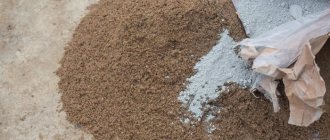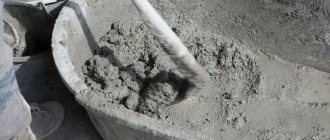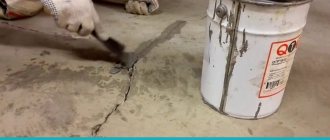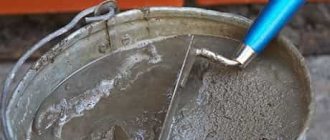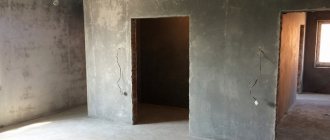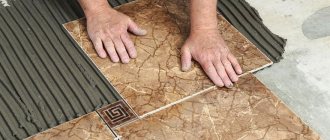Cement mortar is widely used in construction and renovation. It is used for the construction of brickwork, when laying the foundation, internal and external finishing work. No home renovation is complete without cement mortar - it is needed for plastering walls, leveling floors, and laying ceramic tiles.
The technique for making the solution is quite simple - any novice repairman can mix the components. In this material we will figure out how to make cement with your own hands with a small set of tools.
In construction, cement mortar is used when laying foundations, erecting brick walls, and is used in the process of external and internal finishing work.
Correct cement mortar
When mixing the solution, to increase its strength properties, certain additives must be added to this mixture.
Cement mortar is considered the main material during any construction. In recent years, innovative technologies have emerged to improve the quality of cement mortar. If it is necessary to produce a large amount of this material, then special devices are often used. If the building is small, you can make cement mortar without using certain units. All you need for this is some tools and, of course, your own strength. With the correct distribution of the appropriate proportions, you can build a fairly strong structure.
Manufacturers of DSP
The construction market offers a huge number of ready-made dry mixes for preparing CPR:
- "Monolith" - Kirov mixtures M150, used for plastering, sealing joints, laying stone and brick.
- Knauf - legendary German mixtures of brands M75 - M200. Large selection to solve different problems.
- Construction service Novablock - the company produces standard and high-strength mixtures M300.
- "Adamant SPB" - mixtures for private and professional construction from M100 to M400.
- Dauer - durable but inexpensive German mixtures for installing blocks, bricks, pouring floors and finishing walls.
- "BaltPiterStroy" - mixtures from a large Russian manufacturer, a huge selection of brands for any task.
Preparatory work
These activities include the following steps:
- When mixing concrete, it is necessary to thoroughly rinse the crushed stone so that no debris remains in it. Next, it should be passed through a sieve with different cells.
- The sand also needs to be sifted well and then washed.
- Pay special attention to the distribution of proportions. This is the only way you will be able to achieve good quality concrete.
If there is not enough cement in the solution, its strength characteristics will be significantly underestimated, which will subsequently affect the quality of the structure. Too much water that you add to concrete can affect the corrosion of the reinforcement that is in it. On the other hand, if there is less water than needed, the solution becomes dry, loses its plasticizing properties, and is very difficult to work with.
Application of additives
Sometimes the composition of the cement mortar needs some “adjustment”. This is where special supplements come to the rescue. These materials can give the mixture special properties. These additional ingredients are:
- Plasticizers . Their use allows for high-quality pouring of cement, increases its workability, strength and frost resistance.
- Large fillers . Without them, it is impossible to properly mix the concrete mixture, as they provide the necessary strength and reliability.
- Seals . Such additives are designed to waterproof structures located in conditions of high humidity. Compactors are popular in the construction of basements, water tanks or hydraulic structures.
- Hardening accelerators . They are used to compensate for the influence of other additives that slow down the setting process of cement, as well as in the case of construction work at low air temperatures.
- Hardening retarders . Their main function is to extend the “lifetime” of concrete or mortar, if the construction technology involves stage-by-stage work or long-term transportation is required.
- Reinforcing additives . The use of fiberglass prevents the appearance of cracks from the moment of shrinkage until complete drying. Polypropylene fiber provides the material with impact resistance, abrasion protection and durability, which practically reduces the likelihood of defects to zero.
- Corrosion inhibitors . The material in the mixture is able to protect steel reinforcement or other elements from corrosion and destruction.
- Polymer additives . Their presence increases the density, frost resistance, and tightness of cement products.
- Dyes . They are added in the production of paving slabs and various decorative products to give them the required color.
When preparing to mix cement mortar, study the essence of the additives used. The important point is their compatibility and exact proportions for effective “work”.
Mixing the solution in a concrete mixer
To achieve optimal performance, it is necessary to use water with the least amount of salt content.
Of course, mixing the solution using a concrete mixer is much easier than doing it yourself using only shovels. As a result, it is possible to prepare cement mortar much faster in this way. The use of this device on construction sites is relevant in cases where large volumes of work are involved. This, in turn, helps save time and, as a result, money. Mechanization of work makes the process of preparing cement mortar easier, so if you don’t even know how to use a concrete mixer, you shouldn’t give it up.
Mixture components
Building materials based on clinker mixtures are prepared with the addition of fine aggregates and a sealer. The main components of the solution are branded cement, purified sand (less commonly, lime, gypsum) and water with a neutral ph. To improve technical characteristics, modifying additives are introduced into its composition.
Branded cement
Cement is a binding component that increases the strength of the mixture when it hardens. It consists of gypsum, clinker and fillers (belite, anite, magnesite, sodium silicate, or aluminate base). To prepare masonry and plaster mortars with strength M100-200, cement M 400 and M 500 is used.
Fine Aggregates
Structural fillers give the mixture additional volume, plasticity and ensure its workability. Classic additives to cement paste are sand and gypsum. They correct shrinkage and fill unevenness on joining surfaces.
Sand is a component that forms the frame of a frozen mortar. It redistributes the load and prevents the cement from cracking. For masonry mixtures, fine quartz filler is used, for plaster mixtures, purified river sand is used.
Gypsum is a powdery substance added to cement paste for plastering walls and covering surfaces. Reduces the rate of hardening of the material.
Performing work using a mechanical device.
The stirrer bowl should be tilted at 45°. First of all, water is poured into it, after which cement is poured there. Next, sand is added. It is worth understanding that these materials must be added gradually. For example, first you need to add 70% of water from a bucket, then a bucket of cement, then two buckets of sand and wait one minute until the whole thing is well mixed. Then, two more buckets of sand and the rest of the water are poured. If you see that the solution is a little dry, then you need to add a little water, if it is liquid, then add a shovel of cement and half a bucket of sand. In general, the ratio should be: 1 bucket of water, 1 bucket of cement and 4 buckets of sand.
Which brand of cement to choose
As is known, cement is classified according to strength into grades, which were previously designated by the letter M and a numerical indicator characterizing the compressive strength in kg/cm2. The higher the indicator, the more durable products can be obtained from this cement.
Important!
Today, the marking of cementitious powder begins with the type of cement CEM, after which the percentage and type of additives are indicated. Next, the strength class and setting speed are noted. For example, CEM II/V-Sh 22.5N is Portland cement with granulated blast furnace slag 21-35%, strength class 22.5, with a normal hardening rate.
However, many consumers still use the old classification, so some manufacturers put both markings (according to the old and new classification) on bags of cement.
When carrying out work, it is important to choose cement that is optimal in strength in order, on the one hand, to obtain sufficient strength of the products, and on the other hand, not to overpay for more expensive consumables.
This is why the correct choice of the optimal cement brand is so important:
- for plastering facades - CEM II 32.5N–CEM II 42.5N (M400–M500);
- for plastering interior walls for wallpaper or painting - CEM II 22.5N–CEM II 32.5N (M300–M400);
- for masonry mortars, cement grade CEM II 22.5N–CEM II 42.5N (M300–M500) is required, and the mortars are marked by strength from M25 (for unloaded masonry) to M200 (for highly loaded structures, such as foundations on soft soils ), the choice of a specific brand depends on the brand of brick; in the usual case, a mortar of the M50 or M75 brand is selected;
- for screeds, solutions from M200 (screed in an apartment), M300 (screed in an office), and higher for screeds that will be subject to high loads (for example, in industrial premises) are used.
How to mix the solution by hand
The manual method of mixing the solution is most often used in situations where it is needed in small quantities. If you need cement in large quantities, order at https://cement-snab.ru/product-category/tsement/tsement-navalom.
To do this you will need a shovel and a bucket. For this purpose, you need to take a small trough and pour a certain amount of water into it. After this, add cement to this container and mix it with a shovel until a homogeneous mass is formed. Then you should pour sand into the container and continue mixing. As a result, you should get the desired consistency of the cement mortar.
You should have a large mound in the center of the trough or on a metal sheet. Inside it you need to make a funnel into which water is poured. After this, using a shovel, you need to lift the solution from the edges and gradually throw it into the recess. This method requires significant effort. It is used in cases where there is no specific data on the amount of sand or cement. To create better elasticity, liquid soap or shampoo should be added to the solution. If it is produced at sub-zero temperatures, then it is necessary to use plasticizing additives.
In fact, there is no special role in how the solution is mixed. The most important thing is the correct distribution of all materials in their clear sequence. Its quality will depend on this.
Features of calculating sand-cement mortar
Regardless of the purpose for which the mixture must be used, 1 m3 requires a cube of sand. To create a concrete screed, the required amount of cement is calculated taking into account the proportion of 1:3. Thus, to obtain the required mixture you need to take 465 kg of sand. To make the screed, construction mixtures M150 and M200 are also used, for the production of which they use cement M400 and M500, the consumption of which will be 490 and 410 kg per m3.
In the video - cement-sand mixture (ptss), GOST:
Cement proportions for construction
When walls are built using a sand-cement mixture, the traditional ratio is 1:4. Thus, 350 kg will be enough for 1 m3. If sand-lime brick is being laid, the consumption will be less - 0.22 m3. For the construction of load-bearing walls, it is necessary to use higher grades of cement. When lime is present in the solution, a ratio of 1:3 must be used. Read more about the consumption of cement-sand mixture per 1m2 here.
The process of adding water is carried out “by eye” according to how thick the consistency you want to get. Also, a lot depends on the characteristics of the material at the time of calculation of consumption. In this case, viscosity, density and drying time play an important role.
Cement-sand mixture is one of the most popular building materials today. But the wide range of these products very often complicates the process of choosing the appropriate composition. It is also very important to take into account the consumption of the mixture, because it is specific for performing certain jobs. You might be interested to know what a sand cement mortar plastering station is. The link describes a dry cement-sand mixture m 150.
Required proportions of concrete for pouring the foundation
In this case you will need: one part water and cement, three parts sand and four parts crushed stone. If we talk about one part, then most often we are talking about a bucket. Based on these proportions, concrete mixing is performed as follows:
2 buckets of water are added to the container. Depending on the moisture content of the sand, water may need to be added during the mixing process. After this, two buckets of cement are poured there. As it is added, the composition must be thoroughly mixed until a homogeneous mass is obtained. Without interrupting the mixing, add six buckets of sand to the concrete mixer. After this, 8 buckets of crushed stone need to be poured into the cement mortar. All this time, the mixing process must be carried out continuously. After adding the last part of the crushed stone, mix everything thoroughly again and you can start pouring the foundation.
How to choose sand
Sand, its purity and uniformity, will give the solution strength and durability. To choose a filler suitable for diluting a cement mixture, you need to follow the recommendations:
- If you choose between quarry, sea and river types of sand, then preference should be given to the latter. It does not contain impurities and does not require additional washing, unlike other types.
- Sifting the sand before use will help avoid clumps and pieces of shells.
Any sand used for construction purposes has characteristics that are regulated by GOST requirements: particle size, sand density and permissible proportion of impurities. If the filler complies with them, the reliability of the structures is ensured.
Preparation of mortar for brickwork
When making high-quality mortar for stone and brickwork, almost the same principle applies. Less water will be needed, since this solution should dry faster. In this case, the following proportions should be adhered to: 1.5 buckets of water, 1 bucket of cement and 5 buckets of sand. If the masonry will be laid deep in the ground, then this ratio should be 1 bucket of cement to 3 buckets of sand. In this case, the solution must be stronger.
When there is a need to seal any cracks, the solution will need the same consistency as for brickwork - 1:3. This mixture is quite easy to make in a bucket or basin. Add three buckets of sand and one bucket of cement to the prepared container. Make sure that when stirring the solution does not become too liquid, as it will be difficult for it to cover the cracks. Type it in with a trowel. If the solution has the desired consistency, it will not slide off the tool. Since this solution should be used within two hours, it should not be made in large volumes. In some cases, for better strength, lime can be added to it. But because of this, the solution will dry even faster, which means it will be used more quickly.
Proportions for cement-sand mixture (CPS)
The mixture, which contains dry sand and cement, is in great demand today. The reason for this popularity is due to the ease of preparation, low cost and effective results.
To get the required solution, you just need to add water in the right proportion. However, today you can purchase a product that contains plasticizers. The characteristics of the finished solution will depend on the type of these components.
Manufacturers use chemical additives in the preparation process, as thanks to them it is possible to improve the properties of the mixture and ideally match the composition for certain conditions of use.
The result of adding these components will be an increase in the following qualities:
- adhesion;
- waterproof;
- wear resistance;
- resistance to frost.
The video describes the proportions for a cement-sand mixture:
All available cement-sand mixtures have a variety of purposes. They can be used to combat potholes and cracks, during installation of various types, for filling floors and brickwork. There is one main difference between all the types of these products present - these are strength indicators. For example, the M100 brand is characterized by a composition of cement and sand, the ratio between which is 1:3.
In laboratory conditions, the presented product is capable of withstanding a load on a hydraulic press of up to 100 kg/cm2 for 28 days. Thanks to this, it can be actively used for sealing cracks or simply for laying bricks. As for consumption, it can be calculated using the data on the mixture specified by the manufacturer.
If we talk about plasticized mixtures, they are often called “cast concrete” or “rough floor leveler.” To make such material, use a cent grade of at least M200. If this condition is not met, the solution will begin to slide off the walls and spread to the floor.
At its core, a plasticized mixture is the same cement and sand (1:3), but with the addition of a plasticizer. What are these supplements for? Thanks to them, it is possible to dilute the resulting solution to the consistency of liquid sour cream. As a result, it is possible to reduce water demand and improve spreadability.
The presence of a plasticizer ensures excellent hardening, without the formation of cracks that can form during shrinkage. In addition, it is important to add a spoonful of washing powder to the mixture. If you place a tablespoon of powder on a bucket of solution, you can achieve the same effect as when using a mixture with a plasticizer. But many manufacturing plants use plasticizers in a certain proportion to prevent the process of spreading of the finished composition.
Learn how to make textured plaster with your own hands.
Here you can find the size standards for stove bricks.
Photo of the exterior decoration of a house made of sip panels: .
Now it’s worth considering the consumption of a cement-sand mixture of a certain brand and for specific cases. The average consumption of dry cement-sand mixture will be approximately 1.7 -1.9 kg per 1 m2. In this case, the fundamental factor is thickness. If you need to process 1 m2 of surface with a layer thickness of 2 mm, then the material consumption can be 3.6 kg. With a thickness of 5 mm – 9 kg. Separately, it is worth pre-calculating the amount of brick in 1 m2 of masonry.
In practice, the situation is as follows: when pouring a floor whose thickness will remain 10 mm, the material will cost 21-22 ksh/m2. Taking into account these data, we can conclude that 400 kg of M300 sand concrete will be used for 20 m2.

